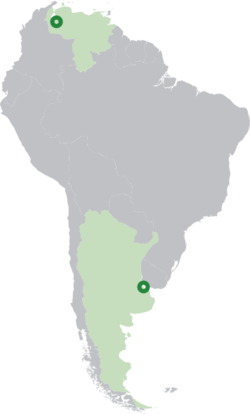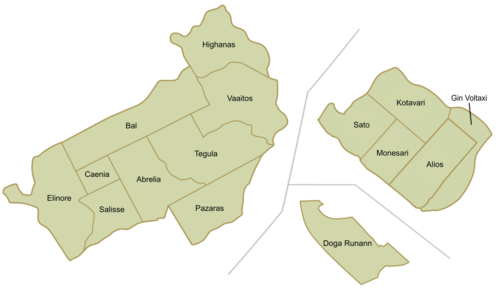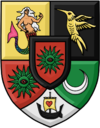Administrative divisions of Sabia and Verona

| Sabia and Verona |
| This article is part of the series |
| Politics and government of Sabia and Verona |
| Constitution |
|---|
| Supreme Court |
| Electoral Commission |
| Foreign relations |
| History |
The administrative divisions of the Kingdom of Sabia and Verona are concerned with the institutional and territorial organization of Sabioveronese claimed territory. There are many administrative divisions, which may have political (local government) or electoral (districts) objectives.
Overview
The current constitution of Sabia and Verona, adopted in 2017, established the present administrative division of the Kingdom, and the Territorial Administration Act adopted by the Constitutional Assembly defined the current borders of the Kingdom's divisions. These are:
- Two territories (dogakurekói): the Northern and the Southern. The territories are not political entities. They are geographical entities; clusters of territories in which the Kingdom is divided. The Northern Territories lay claims in Western Venezuela, while the Southern Territories claim land in Argentina.
- 5 regions (akurekói), including Alios, which is formally considered an autonomous city/municipality with region-status.[1] Out of those five regions, three are autonomous regions and two (including Alios) are centralized regions.
- Autonomous regions have considerable authority over their own affairs. Each autonomous region counts with a powerful parliament, known as the Regional Council and a Governor. All of the autonomous regions are located in the Northern Territories. The autonomous regions do not send representatives to the Parliament of Sabia and Verona, and so their interests are represented in the Kingdom by the United Assembly of Regions.
- Centralized regions are directly administered by the Parliament and the central government through a directly elected Governor. They elect the members of the national Parliament and compose the government. The dependent regions are in the Southern Territories.
- The regions (except Alios) are divided into prefectures (vaonakurekói; also known as "cities", loši) and dependencies (bakiñkoxarai). Prefectures count with a directly elected local administrative officer known as the Prefect. Before the 2017 Constitution, prefectures in the autonomous regions were administered by a local council while prefectures in the centralized regions were directly controlled by the regional authority. Dependencies are directly administered by the regional authority. There are ten prefectures and three dependencies. Alios is divided into three unofficial districts.
Before the adoption of the 2017 Constitution, prefectures (but not dependencies) were divided into municipalities, also previously known as "cities". Municipalities in the autonomous regions counted on a single representative leader (the Burgomeister). Municipalities in the centralized regions did not. At the time of their abolition, there were 22 municipalities in total, of which 16 were in the autonomous regions. A fourth-tier type of geographical division existed shortly from 2014 to 2015, parishes. The parishes never counted with any type of local government and existed mostly for the monarchy to give titles of nobility. They were dissolved with the adoption of the 2015 constitution, but are still used by the monarchy.
Regions
Sabia and Verona's top-tier subdivision type is the region (Sabian: akurekói; Lycene: veedrax). There are currently four regions in Sabia and Verona, as well as the City of Alios which counts with region-level precedence.
Initially, they were two regions alone (the Region of Sabia and the Region of Verona), but in 2014 the neighboring independent nation of Lycem became the Kingdom's third region. After the execution of the Haronos Plan in 2015, the Region of Gonn and the City of Alios became the other two top-tier subdivisions of the Kingdom.

| Flag | Mon | Region | Code | Capital | Joined the Kingdom | Pop. | Area (m2) | Official language(s) | Leader | |
|---|---|---|---|---|---|---|---|---|---|---|
| Sabia | SA | Salisse | 20 October 2012 | 42 | 107.82 | Sabian, Lycene | Carla Mora (J) | |||
| Verona | VE | Tegula | 20 October 2012 | 25 | 84.95 | Sabian | Petyr Cohen (HG) | |||
| Alios | AL | Alios | 25 August 2015 | 23 | 19.32 | Sabian | Andreina Rossini (HG) | |||
| Gonn | GO | Kotavari | 26 November 2015 | 32 | 46,865.06a | Sabian | Dovedán Pashor (HG) | |||
| Lycem | LI | Vaaitos | 23 February 2014 | 9 | 104.32 | Sabian, Lycene | Liam Sanfloss (HG) | |||
| Sabia and Verona | SV | Alios | 20 October 2012 | 131 | 47,181.47 | Sabian, Lycene | Apollo Cerwyn (HG) | |||
- a: Most of the Gonn Region's territory consists of the Doga Runann nature reserve, which acts as a dependency of the region. Without Doga Runann, Gonn is 63.04 m2 in size.
Prefectures and dependencies

The prefectures and dependencies are the second level of subdivision of Sabia and Verona. In total, there are nine prefectures and three dependencies. The dependencies differ from the prefectures in that they don't count with a permanent population. They can't be accessed or permanently populated, and thus maintaining settlements in these areas is impossible. Since they have no permanent affiliated population, the dependencies are directly administered by the government of the Region they belong to. There are currently three dependencies, the Dependency of Pazaras in Verona, the Dependency of Highanas in Lycem, and the Dependency of Gin Voltaxi in Gonn.
Before the adoption of the Constitution of 2017, prefectures were subdivided into municipalities. Prefectures are administered by "prefects", or mayors.
| Mon | Name | Sabian | Pop. | Area | Type | Code | Map |
|---|---|---|---|---|---|---|---|
| Region of Sabia | |||||||
| Bal | bal | 8 | 39.44 m2 | Prefecture | BAL | 
| |
| Caenia | ħaiana | 11 | 9.00 m2 | Prefecture | HAI | 
| |
| Elinore | élinor | 9 | 42.48 m2 | Prefecture | EYR | 
| |
| Salisse | srisa | 15 | 16.90 m2 | Prefecture | SAL | 
| |
| Region of Verona | |||||||
| Tegula | tegula | 13 | 31.10 m2 | Prefecture | TEG | 
| |
| Abrelia | abrelia | 12 | 27.39 m2 | Prefecture | ABR | 
| |
| Pazaras | basra | 0 | 26.46 m2 | Dependency | BSR | 
| |
| Region of Lycem | |||||||
| Vaaitos | vaito | 9 | 59.56 m2 | Prefecture | VAT | 
| |
| Highanas | hríganna | 0 | 44.76 m2 | Dependency | HRI | 
| |
| Region of Gonn | |||||||
| Doga Runann | doga runann | 0 | 46,802.02 m2 | Dependency | DRU | 
| |
| Gin Voltaxi | gin voltaxi | 0 | 14.34 m2 | Dependency | GIN | 
| |
| Kotavari | kotavari | 12 | 20.09 m2 | Prefecture | KOV | 
| |
| Monesari | monesari | 11 | 12.15 m2 | Prefecture | MOS | 
| |
| Sato | sato | 9 | 16.43 m2 | Prefecture | STO | 
| |
References
- ↑ ""Impossible to manage": Alios-Capital region to split". The SiV Phonograph. 25 November 2015.

